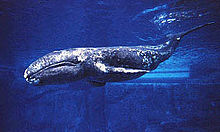Eschrichtiidae
| Eschrichtiidae Temporal range:
| |
|---|---|

| |
| Scientific classification | |
| Domain: | Eukaryota |
| Kingdom: | Animalia |
| Phylum: | Chordata |
| Class: | Mammalia |
| Order: | Artiodactyla |
| Infraorder: | Cetacea |
| Parvorder: | Mysticeti |
| Family: | Eschrichtiidae Ellerman & Morrison-Scott 1951 |
| Genera | |
| Synonyms | |
| |
Eschrichtiidae or the gray whales is a
Taxonomy
In his morphological analysis,
A specimen from the
Steeman et al. 2009 found that the gray whale is phylogenetically distinct from rorquals and that previous morphological studies were correct in the conclusion that the evolution of gulp feeding was a single event in the rorqual lineage.[10] In contrast, multiple later studies found the gray whale to fall within the family Balaenopteridae, being more derived than the minke whales but basal to all other members in the family, and reclassified it in Balaenopteridae; the American Society of Mammalogists has followed this classification.[3][4][11]
Evolution
Fossils of Eschrichtiidae have been found in all major oceanic basins in the Northern Hemisphere, and the family is believed date back to the Late Miocene.[8] Today, gray whales are only present in the northern Pacific, but a population was also present in the northern Atlantic before being driven to extinction by European whalers three centuries ago.[12]
Fossil eschrichtiids from before the Holocene are rare compared to other fossil mysticetes. The only Pleistocene fossil from the Pacific referred to E. eschrichtius is a partial skeleton and an associated skull from California, estimated to be about 200 thousand years old. However, a late Pliocene fossil from Hokkaido, Japan, referred to Eschrichtius sp. is estimated to be 2.6 to 3.9 Mya and a similar unnamed fossil has been reported from California.[8]
In their description of Archaeschrichtius ruggieroi from the late Miocene of Italy,
References
Notes
- ^ Bisconti 2008
- ^ Pyenson & Lindberg 2011
- ^ PMID 31633766.
- ^ a b "Explore the Database". www.mammaldiversity.org. Retrieved 2021-08-20.
- ^ Jones & Swartz 2008, p. 503
- ^ Bisconti 2008, Results, pp. 173–174
- ^ Strobel 1875, p. 136
- ^ a b c Pyenson & Lindberg 2011, Fossil record of gray whales
- ^ Deméré, Berta & McGowen 2005, pp. 119–120
- ^ Steeman et al. 2009, p. 580
- PMID 29632892.
- ^ Bisconti & Varola 2006, p. 450
- ^ Bisconti & Varola 2006, Implications for eschrichtiid fossil record and paleobiogeography, p. 454
Sources
- Anderson, J. (1746). Nachrichten von Island, Grönland und der Strasse Davis (in German). Hamburg: Verlegts Georg Christian Grund, Buckdr.
- Barnes, L. G.; McLeod, S. A. (1984). "The Fossil Record and Phyletic Relationships of Gray Whales". In Jones, M. L.; Swartz, S. L.; Leatherwood, S. (eds.). The Gray Whale: Eschrichtius Robustus. Academic Press. pp. 3–28. ISBN 9780080923727.
- Bisconti, M. (2008). "Morphology and phylogenetic relationships of a new eschrichtiid genus (Cetacea: Mysticeti) from the Early Pliocene of northern Italy". Zoological Journal of the Linnean Society. 153: 161–186. OCLC 438026086.
- "M. Bisconti 2008". Fossilworks.
- Bisconti, M.; Varola, A. (2006). "The oldest eschrichtiid mysticete: and a new morphological diagnosis of Eschrichtiidae (gray whales)" (PDF). Rivista Italiana di Paleontologia e Stratigrafia. 112 (3): 447–457.
- "M. Bisconti and A. Varola 2006". Fossilworks.
- OCLC 13184910.
- Bryant, P. J. (1995). "Dating Remains of Gray Whales from the Eastern North Atlantic". Journal of Mammalogy. 76 (3): 857–861. JSTOR 1382754.
- Deméré, T.A; Berta, A.; McGowen, M. R. (2005). "The taxonomic and evolutionary history of fossil and modern balaenopteroid mysticetes" (PDF). Journal of Mammalian Evolution. 12 (1/2): 99–143. S2CID 90231.
- S2CID 186208376.
- OCLC 469669291.
- "J. R. Ellerman and T. C. S. Morrisson-Scott 1951". Fossilworks.
- OL 23666710M.
- "Eschrichtius Gray 1864 (gray whale)". Fossilworks.
- .
- Jones, M. L.; Swartz, S. L. (2008). "Gray whale". In Perrin, William F.; Würsig, Bernd; Thewissen, J. G. M. (eds.). Encyclopedia of Marine Mammals. Academic Press. pp. 503–511. ISBN 978-0-12-373553-9.
- OCLC 670223335.
- Portis, A. (1885). Catalogo descrittivo dei Talassoterii rinvenuti nei terreni terziarii del Piemonte e della Liguria (in Italian). Turin: Ermanno Loescher. OCLC 9527515.
- "A. Portis 1886". Fossilworks.
- PMID 21754984.
- JSTOR 4060095.
- Scammon, C. M. (1874). "The California Gray Whale". The marine mammals of the north-western coast of North America. San Franc.: John H. Carmany and Co. pp. 20–33.
- Steeman, M. E.; Hebsgaard, M. B.; Fordyce, R. Ewan; Ho, S. Y. W.; Rabosky, D. L.; Nielsen, R.; Rahbek, C.; Glenner, H.; Sørensen, M. V.; Willerslev, E. (2009). "Radiation of Extant Cetaceans Driven by Restructuring of the Oceans". Systematic Biology. 58 (6): 573–585. PMID 20525610.
- Strobel, P. (1875). "Notizie preliminari su le Balenoptere fossili subappennine del Museo parmense". Bollettino del R. Comitato Geologico d'Italia (in Italian). 5 (6): 131–140.
- "P. Strobel 1875". Fossilworks.
- .
- "P. J. Van Beneden and P. Gervais 1868". Fossilworks.
- OCLC 2662569.
- "M. Weber 1904". Fossilworks.
- Whitmore, F. C.; Kaltenbach, J. A. (2008). "Neogene Cetacea of the Lee Creek Phosphate Mine, North Carolina". Virginia Museum of Natural History Special Publication. 14: 181–269.
- "F. C. Whitmore and J. A. Kaltenbach 2008". Fossilworks.
External links
 Media related to Eschrichtiidae at Wikimedia Commons
Media related to Eschrichtiidae at Wikimedia Commons Data related to Eschrichtiidae at Wikispecies
Data related to Eschrichtiidae at Wikispecies
